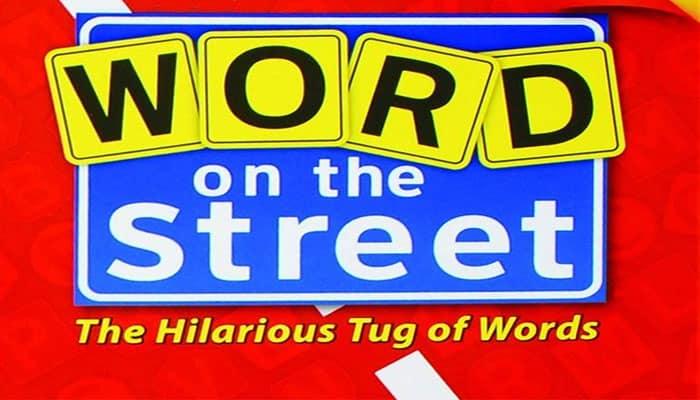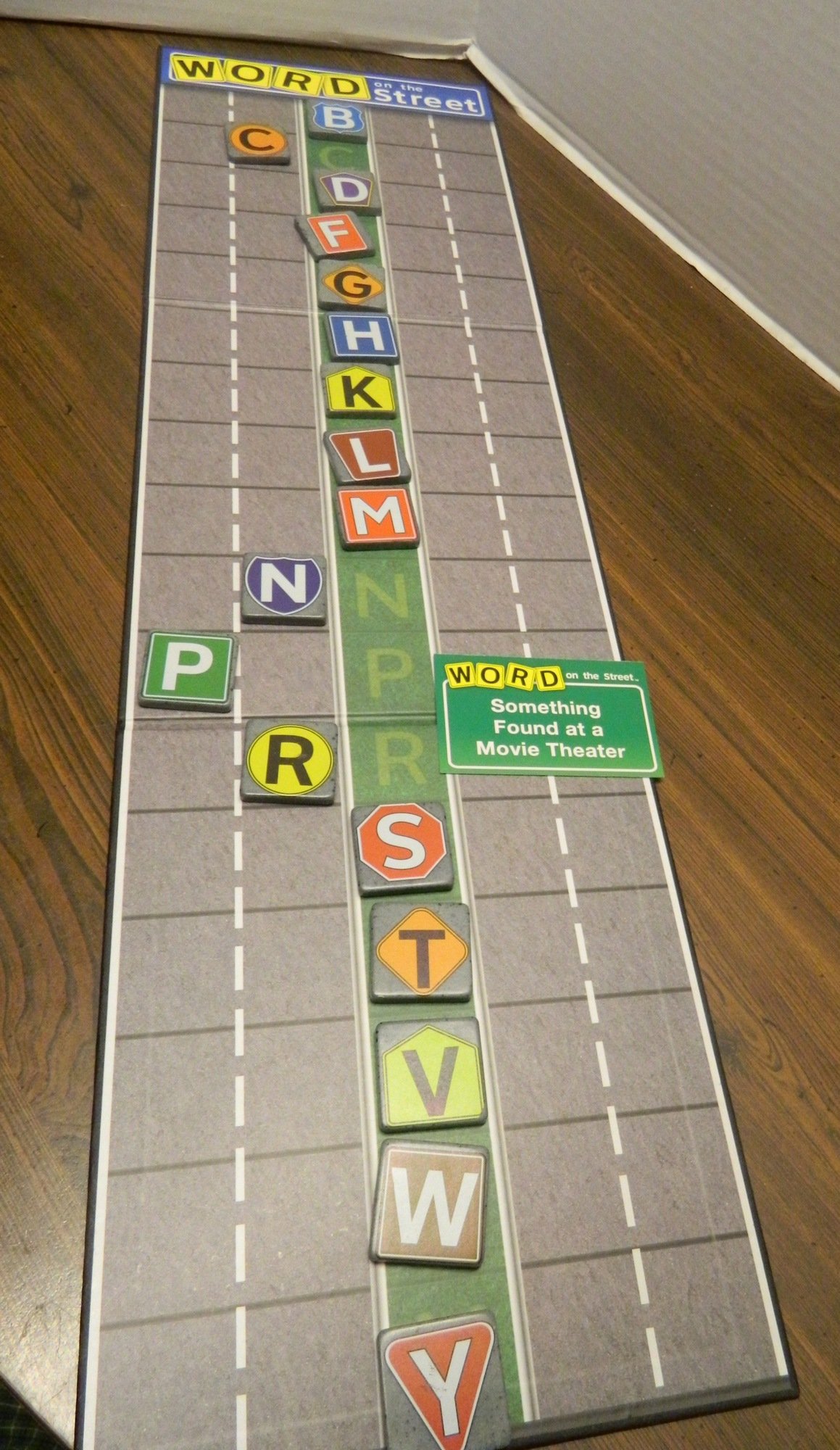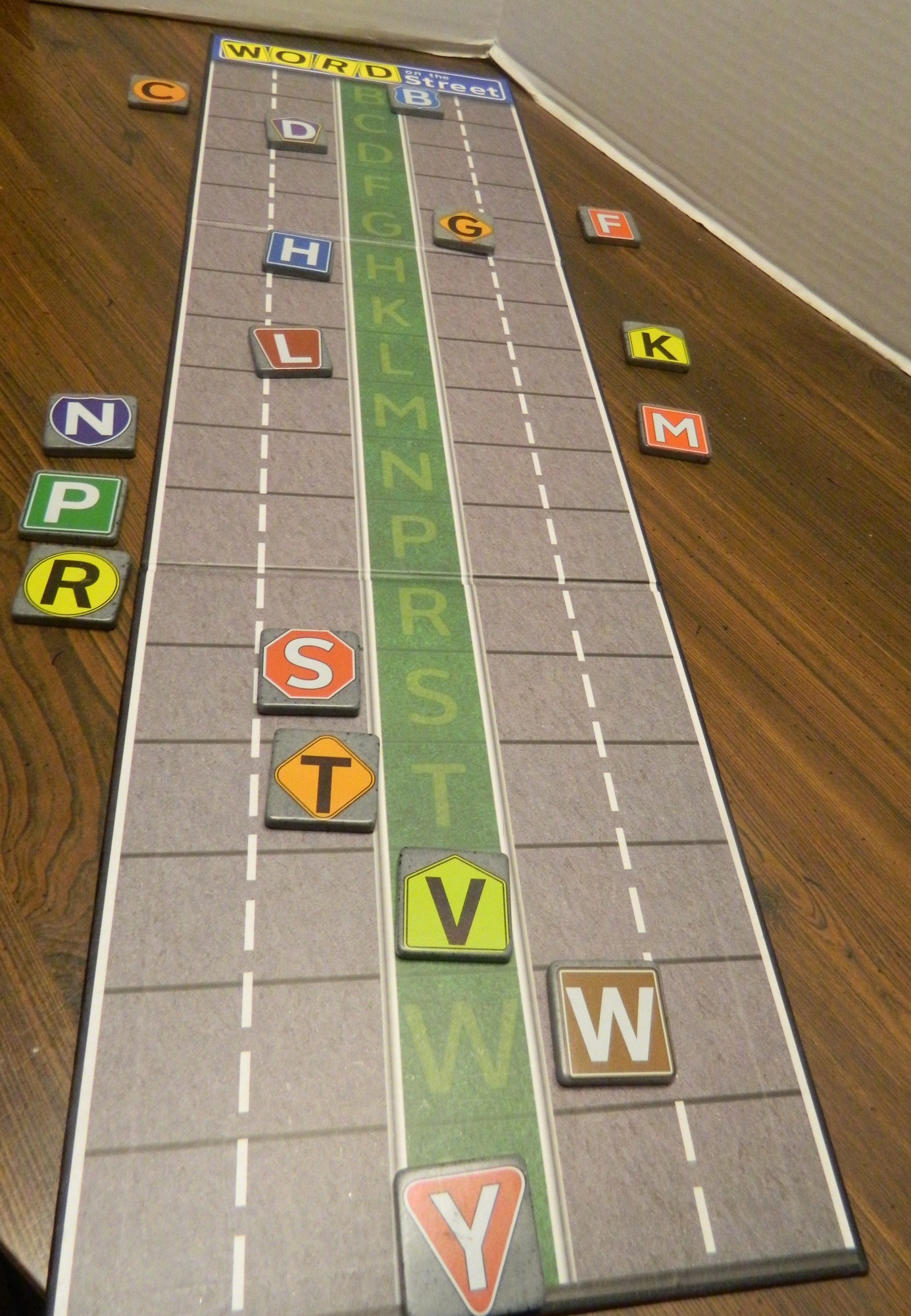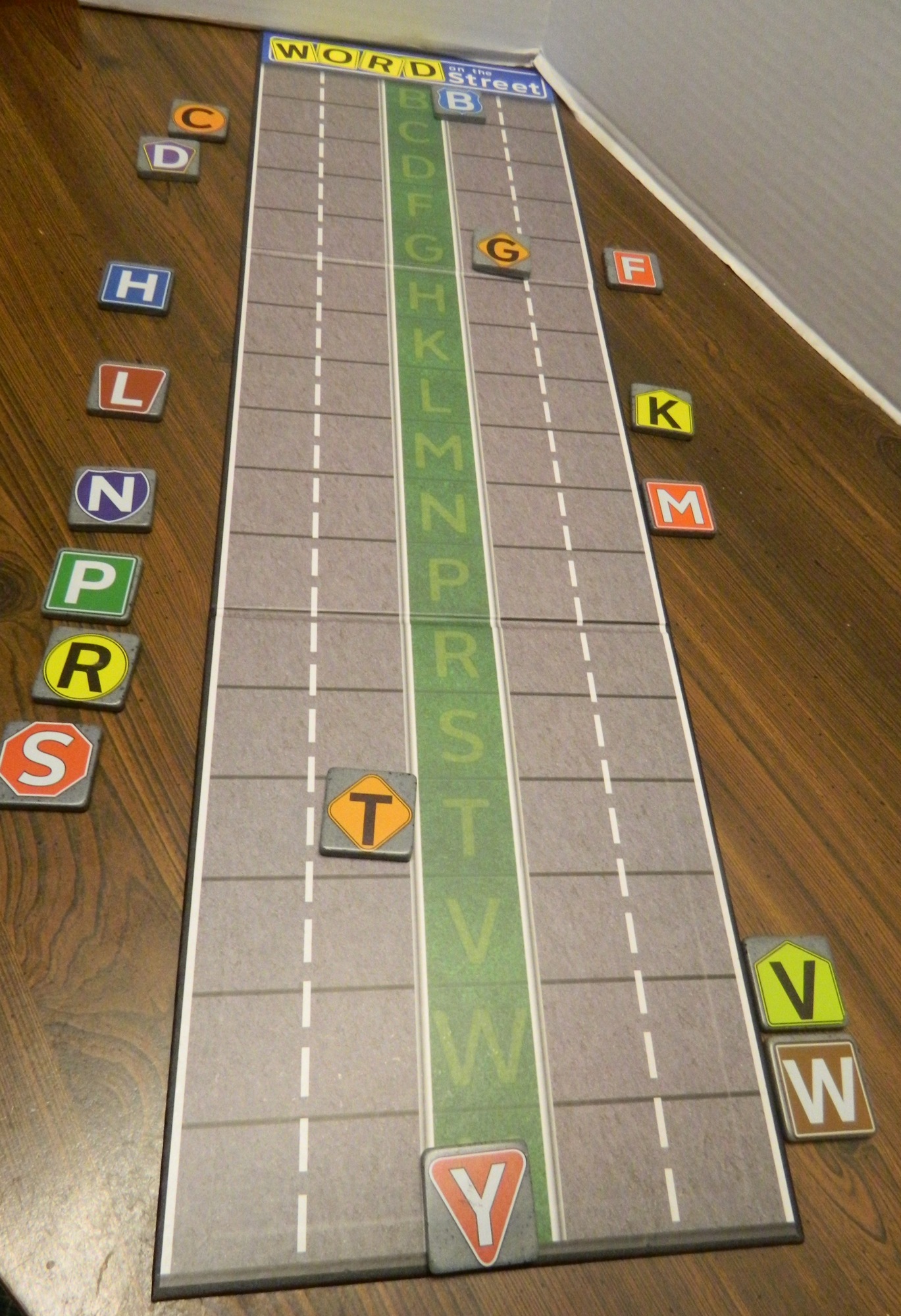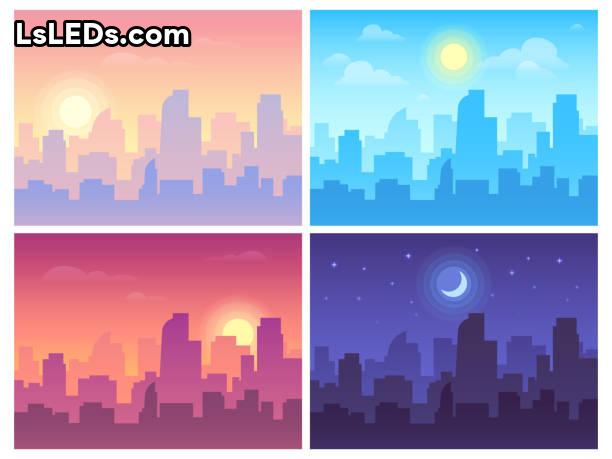Components
- 17 Letter Tiles
- 216 Category Cards (432 categories)
- Divider Card
- Card Tray
- Timer (30 Seconds)
- Game Board
- Rule Sheet
Object of the Game
Capture Letter Tiles by selecting words that contain the desired letters and pulling the letters off the street before the opposing team can pull them back.
The first team to capture eight Letter Tiles wins Word on the Street!
Setup
-
Divide the players into two teams. If there is an odd number of players, decide which team should have the extra player.
-
Place the game board between the two teams, as shown in the graphic below.
-
Place each Letter Tile on the corresponding letter on the «Median Strip» (middle lane) of the game board.
-
Select which side of the Category Cards will be used for the game. The categories on the blue side are a bit more challenging than those on the green side. Place the Category Cards in the card tray, with the selected side facing forward.
-
Place the timer and the card tray at one end of the game board, within reach of both teams.
-
Determine which team will take the first turn.
Game Play
Teams alternate taking turns «on the street» until one team has captured eight Letter Tiles. A turn on the street consists of the following five steps:
A player from the team on the street draws the first card from the card tray, and places it on the table, with the selected color facing up, and reads the category aloud. At the same time as the card is drawn, a player from the opposing team flips over the timer.
Players from the team on the street brainstorm words that fit the category printed on the Category Card. See Allowable Words.
The team must agree on one word, say the word aloud, and move each Letter Tile that corresponds with a letter in the selected word, before the time runs out. See Moving the Tiles.
When time runs out, a player from the opposing team says «Stop» and the team on the street must immediately stop moving Letter Tiles. That team’s turn is now over and the Category Card is placed in the back of the card tray. See Challenging a Word Selection or Spelling.
The opposing team becomes the new team on the street and begins its turn with Step 1 of Playing the Game. Note: Make sure that all the sand in the timer has run through before starting a new turn.
Allowable Words
-
Word selections must be in the form of a single word.
-
Any word in the English language is allowed, including words that are capitalized, such as the names of persons and places.
-
Singular and plural forms of words are both allowed as long as the selected word fits the category named on the Category Card.
For example, «Olives» would be allowed for the Category Card «A Pizza Topping» because olives are generally considered one topping. However, «Pineapples» would not be allowed because it is generally written as «Pineapple» when listed as a pizza topping.
-
Present and past tense forms of words are allowed as long as the selected word fits the category named on the Category Card.
For example, «Cooked» would be allowed for the Category Card «Something a Player did Today» because it is the correct tense, but «Cooked» would not be the correct tense for the Category Card «Something you can do with an Onion».
-
Hyphenated words are only allowed when the hyphen is part of a name, such as in «Zeta-Jones» or «Winston-Salem».
-
Compound words are allowed because they are a single word.
For example, «Sandbox» is allowed because it’s a single word, but «Sand Dollar» is not allowed because it is two words.
Challenging a Word Selection or Spelling
During the brainstorming phase of the game, players from either team are free to suggest any words they wish. After the time is up and the tiles have been moved, if the opposing team thinks that the team on the street has made an error in either spelling or word selection, they may raise a «Challenge».
A challenge may result in either the team on the street having to move tiles back, or the team raising the challenge losing their next turn.
Spelling, Hyphenated Word, and Compound Word Challenges:
All players should work together to attempt to determine if the selection is a single word and is spelled correctly. If the dispute is not resolved by consensus, a dictionary or other reference may be checked.
-
If the spelling is found to be correct, the Letter Tiles remain in their new positions and the team raising the challenge loses their next turn.
-
If the spelling is found to be incorrect, all tiles moved before the error remain in their new positions and the tile moved in error and all subsequent tiles are returned to their previous positions.
-
If the selection is in fact two words rather than a compound word, or is not allowed because of the use of the hyphen, all Letter Tiles for the word, or words, are returned to their previous positions.
Word Selection Challenge:
If the opposing team challenges a word selection, the team on the street must explain why they believe their selection fits the category on the card. If a majority of the players accept the explanation, the Letter Tiles remain in their new positions.
If a majority of the players reject the explanation, all Letter Tiles for the word are returned to their previous positions. If there is an equal number for and against, the Letter Tiles for the word are returned to their previous positions and the team on the street restarts their turn with a new card.
Moving the Tiles
Each Letter Tile is moved one space, toward the team on the street, for each time that letter appears in the selected word.
-
Once the first Letter Tile has been moved, the team may not change their selected word.
-
Members of the team on the street spell the word aloud and the tiles are moved, in order, as the letters are announced.
-
Only one player from the team on the street may move the Letter Tiles, per turn.
-
The opposing team is not allowed to move tiles.
-
If a team moves a Letter Tile off their side of the street, that team has captured that tile. Captured Letter Tiles never move back onto the street.
-
Teams may select words which include letters that have been captured but the captured Letter Tiles are not moved.
-
Captured Letter Tiles remain next to the board to show how many tiles each team has captured.
Example:
Team B selects the word purple:
-
P is announced and moved one space
-
U is announced but no letter is moved
-
R is announced, moved off the board, and is now captured by the team on the street, Team B.
-
P is announced again and moved another space
-
L is announced but no letter is moved because the L was already captured by the opposing team, Team A.
-
E is announced but no letter is moved
Sidetracking
Part of the fun, and challenge, of Word on the Street is trying to throw the team on the street «off course».
During the brainstorming phase, the opposing team is encouraged to suggest words for the category, regardless of how helpful or distracting they may be.
For example, the opposing team might suggest «Red» for the Category Card «A Color» because it would limit the team on the street to only two Letter Tiles. The opposing team might even suggest «Rhinoceros», which does not work at all, but might distract the team on the street and waste their valuable time!
Although «Sidetracking» is permitted during word selection, in the spirit of the game, players should be honest when addressing questions of allowable words. See Allowable Words.
End of the Game
The first team to capture eight Letter Tiles wins Word on the Street!
Notes
-
The letters included in the game are: B,C,D,F,G,H,K,L,M,N,P,R,S,T,V,W,Y. The vowels A, E, I, O and U, and the letters J, Q, X and Z were excluded to streamline the game.
-
Category Cards do not include any time references. All categories should be assumed to include people, places, things, and events from the past and present.
-
Some Category Cards refer to either «A player» or «one of the players». These cards refer to the people currently playing the game.
-
When the complete set of cards has been played, the Divider Card will be in the front of the card tray.
Shuffle all Category Cards and place them back in the card tray with the Divider Card in the back. You are now ready for many more hours of fun playing Word on the Street!
Continue Reading
HOW TO PLAY
Word On The Street is a fun educational word game that is great for up to six players or you can even split players up into teams and play that way. The basic gameplay is you’ll be tasked to pull letters off the street before the opposing team can pull them back. If you can capture eight letter tiles before your opponents can then you’ll win.
Great for home or school, Word On The Street makes learning words and spelling fun. There are even quick play and family variations for younger players in the game rules. With fun graphics and illustrations this board game is a winner for younger audiences. Purchase your copy of Word On The Street today.
WHAT’S INCLUDED
The game Word On The Street should come with the following components. These are based off of the original game and don’t include components from any expansion packs or different editions.
- This Game Comes With A Game Board
- 17 Letter Tiles
- 216 Category Cards
- Tray
- 30-second Sand Timer
- Official Word On The Street Game Rules And Instructions
HOW TO WIN
The first team to capture eight letter tiles wins.
OFFICIAL GAME RULES
Please keep in mind that the official Word On The Street rules and instructions could be different depending on the game version you have. The rules below are some of the exact directions that came in the original packaging and will teach you how to play Word On The Street. Download these original PDF game rules or print them for later use.
- Official Word On The Street Game Rules
- Official Word On The Street Junior Game Rules
COMMENTS / QUESTIONS
Share with us your comments, funny stories, tips, advice, strategies, creative ways to play, questions about how to play, problems with the directions or anything you want about Word On The Street. All submissions will be reviewed within 24 hours.
Name:
Comment:
Human Question:
Which game starts with the same letter as Mancala: Chess, Uno, Monopoly, Battleship or Rummycube
No comments have been submitted. Add yours today!
OTHER GAME RULES
Here are some other games you might like to read through the game rules. Browse these games and see if you can find a new favorite game to play at your next game night. You can also use our search feature at the top of the page to search for a specific criteria that might interest you.
Word on the street
In this article, you can read about the basic rules of the game Word on the Street and learn how to play. The object of the game is to be the first team to pull eight letters off your side of the board.
Setup
Set up the board in the middle of the table and divide the players into two teams who sit on either side. Make sure the category cards are all the same directions as this will be what everyone plays with. The blue side is more challenging than green. Place the category cards and timers on one end. And, place all the letter tiles on their corresponding positions in the center of the board.
Word on the Street Gameplay
Teams alternate taking turns. On your team’s turn draw a category card and the opposite team flips the timer. You now have 30 seconds. Read the category aloud, brainstorm possible answers to single words that fit that category.
Pick one of those words and begin to spell it. One person then pulls letter tiles toward your team as each letter is spelled in that word. If at any time the timer runs out, your team must stop wherever you are and end your turn. Place the category card back in the tray it is now the other team’s turn.
Words allowed
The word you’re allowed to use is any single English word. Capitalization doesn’t matter and it may only be hyphenated if it’s part of a name. Such as, in and out or zeta-jones.
Additionally, the plurality and tense of a word must match the context of the category. If your category is pizza topping you could say olives but not pineapples because it is generally written as pineapple when listed as a pizza topping. Cooked is an acceptable answer for something you did today but for something you do with an onion you don’t ‘cooked’ an onion you ‘cook’ an onion.
Compound words are also allowed. The opposing team may challenge your word if they think you spelled it incorrectly, chose two words instead of one, didn’t choose a real English word, or if your word doesn’t fit the category.
If the spelling is incorrect, move back all the tiles after the spelling error. If the spelling is correct, then the challenging team loses their next turn. Also, if the challenge is about a word being multiple words, or not being a real word, and is proved to be incorrectly played, then all the letters return to their previous position. Otherwise, the challenging team loses a turn.
Challenging a word
If a team challenges you on the word fitting into a category, then you must give an explanation as to why you think your word is appropriate. If the majority of players reject the explanation, then all their tiles return to their previous positions. Then you end your turn. Lastly, if there is a tie for rejecting the word, then the word is rejected. Next, the team restarts its turn with a new category card. Each letter is moved one space towards your team for each time it appears in a word.
Once you move the first letter of a word, you may not change your word. Your team must spell the word aloud as the tiles are moved one at a time by one person. Once a letter is moved off the street it has been captured. It may no longer be moved when used in a word. It remains visible there until the end of the game.
Summary
The opposing team is allowed to try and sidetrack the current team by saying words allowed during the brainstorm. They may say completely wrong words or short unhelpful words. Remember, the spirit of the game is, to be honest, and have fun not to be obnoxious. There are letters not present on the board. You may use them in a word you just don’t move a tile when doing so. The first team to get 8 tiles off their side of the board wins.
There is also a game version called Word on the Street Junior that is played very similarly.
There are a few versions of the game Word on the Street available on the market. I leave the link to the game that I refer to in this post.
Feel free to share this post.
Mircic91.com is an affiliate. As an Amazon Associate I earn from qualifying purchases.
How to Play | Review | Final Verdict | Comments
How to Play
Setup
Divide into two teams. Place all of the letter tiles on their corresponding spots in the middle of the gameboard. Decide whether you are going to use the green (easier) or blue (harder) side of the cards. Determine which team will start.
Playing the Game
Teams take turns as the team “on the street”. The next card is flipped over to the side both teams agreed to (green or blue) and the timer is flipped over. Players from the “on the street” team need to brainstorm words that fit the category from the card that was flipped over. The team must agree on one word before the timer runs out. When coming up with words players need to consider the letter tiles out on the board. When a team chooses their word they get to move all of the letter tiles that are part of the word they chose one space towards their side of the board. If a letter appears in the word more than once, that letter moves as many spaces as it appears in chosen word. The team must choose their word and move all of the tiles before the timer runs out though.
This team has to come up with a word that fits the category “something found at a movie theater”. This team has chosen the word “popcorn”. The letters c, n, and r appear in the word once so they are moved one space towards the current team’s side of the board. Since the letter p is in the word twice it moves two spaces towards the team’s side of the board.
If a tile is ever moved off one side of the board, that team has captured that letter tile. The other team can still use that letter in words they come up with but they cannot move captured letter tiles back onto the gameboard.
At this point in the game the c, n, p, r, f, k, and m tiles have been captured.
When deciding on words to use the following rules must be followed:
- The word chosen must be a single word.
- Any English word is allowed even capitalized words.
- Singular and plural forms of words can be used if they make since for the category.
- Past and present tenses are allowed if they work for the category.
- Hyphenated words are only allowed when they are part of a name.
If the other team does not think the word the other team chose for the round is spelled correctly or doesn’t fit the category, they can challenge the word. If there is a challenge of whether the word fits the category a vote is held to decide if it should count. If the vote ends up in a tie, all of the tiles are returned to their previous spots, but the team that was “on the street” gets to redo their turn. If the word is determined to be incorrect, all tiles moved have to be moved back and the current team does not get a new turn. If the word is determined to be correct, the challenging team loses their next turn.
End of Game
The game ends when one team has captured eight of the letter tiles. This team wins the game.
The team on the left side of the board has captured eight tiles and has won the game.
One of the more popular board game genres is the word game. Ever since Scrabble became a huge success many board game designers and publishers have tried to make their own word games. These games generally borrow pretty heavily from games like Scrabble where you score more points for creating longer words and using less common letters. As a whole I have mixed feelings about the word game genre. I enjoy word games. The problem with the genre though in my opinion is that very few games in the genre do anything new so once you have played a word game it feels like you have played all of them. I am always on the lookout for interesting word games though which brings me to Word on the Street created by Out of the Box.
Word on the Street is one of the most original word games that I have played in quite some time. Word on the Street feels like a mix of Scrabble, Scattergories, and tug of war. The basic mechanic in the game is spelling/coming up with words like every other word game. Word on the Street adds a Scattergories mechanic where you have to come up with a word that fits the category of the card that was just drawn. Finally there is the tug of war element as players are fighting back and forth for letter tiles trying to capture them for themselves. This unique blend of mechanics makes Word on the Street one of the better word games I have played in quite some time.
One of the most interesting things about Word on the Street is that it has quite a bit of strategy for a word game. Games like Scrabble have some strategy as far as where to play tiles but the game mostly relies on a large vocabulary so you can maximize the use of your tiles. Word on the Street is interesting because you have to make strategic decisions over what letters you try to use in words. You can either play offensively mostly trying to capture tiles for yourself or you can play defensively by keeping tiles from your opponents. Unless you are significantly better than your opponents though you really can’t just play offensively or defensively since you can’t win with either strategy by itself. You need to do a good job deciding when to try to capture tiles and when to prevent the other team from capturing tiles. Sometimes the category card you are dealt will make that decision for you but you usually have more of a decision than you would think.
Being a word game, having a strong vocabulary/spelling skills is obviously helpful. I don’t think it is as important as it is in other games though. This is because to do well in Word on the Street you don’t always need to use the longest words that you can. Sometimes a three to four letter word can be just as valuable as a seven or eight letter word if it uses the right letters. A team that has a stronger vocabulary will clearly have an advantage in the game but I don’t know if they will always win like they would in most word games. A team that is good at controlling the tiles on the board could end up winning the game even if the other team uses longer words.
The key to this is the fact that words that use multiple instances of a letter are very valuable in Words on the Street. The key to capturing tiles is using words that have repeat letters. Unless a team is really unlucky with category cards or just ignore a particular letter, it is pretty easy to prevent a team from capturing a tile. Teams will end up letting the other team capture some tiles (unless they are that much better than the other team), but when it gets towards the end of the game it becomes really hard to make any progress without using words that use duplicate letters. Using words with three or more of the same letter can be used to steal a letter out from another team.
Word on the Street has a recommended age of 12+. While young children won’t be able to play the game, I think the accessibility of the game will come down to a player’s vocabulary/spelling skills. The game itself is pretty easy and children should have no problem understanding how to play the game. I think children under 12 with good vocabulary skills shouldn’t have a problem playing the game before age 12.
Word on the Street is a fun game but does kind of have an end game problem. When you get to only around five or so tiles remaining, the game tends to grind to a halt. This occurs since the players start narrowing their focus to the letters that remain on the board. This means that players will spend all of their time on these letters which means that they can usually come up with a word that uses at least one of the letters. On top of all of this, the usual letters (V, W, Y) are likely to be some of the letters remaining. This means that your words are rarely going to use a letter twice since how many words use two v’s, w’s, or y’s?
So at this point in the game, it truly becomes a game of tug of war. Unfortunately it is not a good game of tug of war. Usually one player moves one or two of the tiles one space towards their side of the board. Then the other team reverses that by coming up with their own word that uses the same tiles. The only way to really capture tiles at this point is to have one team get category cards that don’t work for a letter while the other team gets category cards that work for a particular letter. I think it might take longer to get the last one or two tiles than it takes to get the rest of the tiles required to win the game. Word on the Street is a fun game that screeches to a halt at the end as one team limps to the finish line.
I think this problem can be fixed pretty easily though. I think the only thing you have to do is reduce the number of tiles you need to win the game. Reducing the tiles needed to win to six or even seven tiles will make a world of a difference. This should fix the problem because there will be more tiles still on the board at the end of the game so there will be more possibilities for the players. Players won’t all be going for the same tiles so the tiles shouldn’t keep moving back and forth as often.
Other than the problems with the end game stalling, the only other problem that I have with the game is that all of the category cards were not created equally. First I don’t know if I agree with the game’s opinion on which categories are easier. I found the blue side on a lot of the cards to be easier than the green side. Otherwise I just found some cards to be considerably better than others. This means that card draw luck does have an impact on the game. The problem with some of the cards is that they only give you a limited set of answers while others give you a ton of words that you can use. This means that teams that get the better cards have a lot more flexibility and are more likely to move more tiles on their turn. The game has quite a bit of skill which makes it kind of a shame that luck plays a role in determining the winner of the game.
Like a lot of Out of the Box’s games, Word on the Street should be commended on the quality of it’s components. While the gameboard is a little on the bland side, it serves its’ purpose. The letter tiles are quite thick and are nice. While it is just a cosmetic thing, I like when publishers include quality components with their games. Another thing that I really like about the components is the pure quantity of cards included. The game includes 216 cards which means you can play 432 rounds without one repeat category. I honestly think you will never run out of cards to use for the game since by the time you play through all 432 categories you will forget what word was used for the card the first time you played it.
Final Verdict
I have to say that I was pleasantly surprised by Word on the Street. It is one of the better word games that I have played recently. I was worried that the game would play like every other word game but it actually plays quite a bit differently. There is a lot more strategy to the game than a lot of word games. Also while a strong vocabulary will help, it is possible for a team to win the game against a team with a better vocabulary utilizing a good strategy of choosing which tiles to target. Word on the Street is not perfect though. The end game drags on for too long and luck comes into play based on card draw luck
If you hate word games, Word on the Street is probably not going to change your opinion. It has more strategy than most word games but the basic mechanics are the same as every other word game. If you like word games I would seriously consider Word on the Street. Even if you already own a lot of word games I would consider Word on the Street since it brings something new to the genre.
If you would like to purchase Word on the Street, you can purchase it on Amazon here.
How do you play word on the street game?
What is word on the street game?
Word on the street is a game that encourages kids to answer a question with answers that start with a certain letter of the alphabet. My 6 1/2 year old can read and come up with interesting answers in this game, so he has to be able to read to use it.
What word has all 26 letters in it?
There are 26 letters of the English alphabet in an English panogram. “The quick brown fox jumps over the lazy dog” is a well-known English pangram. Most discotheques don’t provide music.
Is word collect a free game?
Word Collect is one of the best free word games.
What’s the word on the street Sesame Street?
A regular feature on Sesame Street was What’s the Word on the Street? The corporate sponsor spots precede the segment hosted by Murray Monster.
How do you play Street Junior on word?
How do you get word on the street?
Pick words that contain the letters you want and pull them from the street before the opposing team can pull them back. Word on the Street was won by the team that captured eight Letter Tiles.
How much money do you start with in life junior?
There is a person who is a bank teller. The player with the most money will be the bank player. Each person is given $10,000 by the bankers after they organize the money. Each player has a choice of a peg or a car to put in the driver’s seat.
How long is the timer in Word on the street?
How long is the timer in last word?
The timer emits an annoying buzz after a five to ten second period, but it’s neat. The cards are of good quality, and the box is large enough to hold everything.
How long is the taboo timer?
Can you tell me how long the Taboo timer is? When you flip it, the timer lasts one minute.
What are some good categories?
When playing the categories game, you can use these categories: countries, games and sports, cities, animals, food and drink, verbs, adjectives, jobs, famous people, things you find in the bathroom/ kitchen, and fruit and vegetables.
What are the rules for outburst?
Two teams are playing a game of quick thinking and talking. Each team is given a topic and given a minute to answer questions. You will score one point for your team if you yell out one of the answers.
What is that game where you have to guess the word?
Taboo is a word, guessing, and party game that was published by theParker Brothers. The goal of the game is for the player to have their partners guess the word on the player’s card without using the word itself or five additional words listed on the card.

